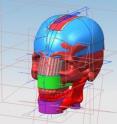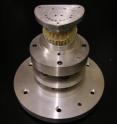From human bite to robot jaws
Related images
(click to enlarge)
The UK spends around £2.5 billion each year on dental materials to replace or strengthen teeth*. The Chewing Robot is a new biologically inspired way to test dental materials and it will be shown to the public for the first time at this year's Royal Society Summer Science Exhibition [30 June to 4 July]. Researchers at the University of Bristol's Department of Mechanical Engineering in collaboration with the Department of Oral and Dental Science have developed the Chewing Robot to study dental wear formation on human teeth.
Dental elements, such as crowns and bridges, are made from well-known metals, polymers and ceramics but their dental wear properties are often poorly understood. Clinical trials examining the wear of human teeth are expensive and time-consuming. By the time a new material has been tested, it is often obsolete.
The movements and forces involved in natural chewing action have been replicated using the new chewing simulator -- the Chewing Robot. The robot is based on a three-dimensional mechanism with six linear actuators that reproduce the motion and forces sustained by teeth within a human mouth.
A human jaw is a powerful and complex piece of natural machinery, allowing a person to chew in many different ways. The lower jaw and the teeth move with six degrees of freedom, translating and rotating along each of the Cartesian axes.
Dr Kazem Alemzadeh, Senior Lecturer in the Department of Mechanical Engineering recognised that the Stewart-Gough platforms have been used to provide and control the same six degrees of freedom in aircraft simulators, and so he proposed the Chewing Robot concept based on just such a platform. The design and development of the Chewing Robot was carried out by Daniel Raabe, a PhD student in the Department of Mechanical Engineering.
The robot has the potential to dramatically improve the process of developing and testing new dental materials.
Daniel Raabe said: "By reproducing natural bite forces and movements, the Chewing Robot can help improve and accelerate the process of developing new dental restorative materials that may someday be found in a person's mouth."
Source: University of Bristol
Other sources
- From human bite to robot jawsfrom PhysorgTue, 30 Jun 2009, 11:28:32 UTC


